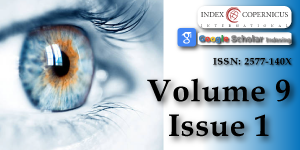Impact of Refractive Error Correction on Vision Related Quality of Life in School-Aged Children-A Prospective Interventional Study
Main Article Content
Abstract
Aim: To compare the vision related quality of life before and after prescription of refractive glasses in school-aged children.
Design: A prospective, comparative, and hospital-based interventional study was conducted at the Regional Institute of Ophthalmology, PGIMS, Rohtak between May 2021-May 2022. It involved assessment of vision-related quality of life (VRQoL) in 200 school-going children of the 5-16 age group, then comparing outcomes in children with URE versus those corrected with eyeglasses. Those with significantly low visual acuity (≤ 6/9) on Snellen’s were enrolled in the study after obtaining written informed consent from parents. The Modified SREEQ was used to assess VRQoL. Various parameters of comparison included age, gender, demography, education, and improvement in VRQoL within individual study groups over time. Comparison was done before and after using prescription refractive eyeglasses with a follow-up period of 3 months.
Results: The correction amongst hypermetropes, 40 out of total 200 students (20%), correction among myopes (153 of 200 students), correction amongst students with astigmatism (7 out of 200 students) resulted in changing categories from mild/moderate/severe visual impairment to normal category of visual acuity i.e., 6/6 on immediate correction with refractive glasses prescribed to them post refraction. Students with astigmatism showed an improvement in symptoms like distorted images post-refractive correction at 3 months. Thus, proving a positive role of refractive eyeglasses in reducing the burden of refractive errors in our study population and improving the visual outcome.
Conclusion: VRQoL was better in students after they got their refractive errors corrected with prescription eyeglasses at 3 months as compared to their QoL evaluated at their first visit to our centre with URE. This study focused on having a holistic approach towards improvement in QoL by taking into consideration the academic, psychological, cost-effectiveness aspects of VRQoL among students in the age group 5-16 years old.
Article Details
Copyright (c) 2025 Rathi A, et al.

This work is licensed under a Creative Commons Attribution 4.0 International License.
Lou L, Yao C, Jin Y, Perez V, Ye J. Global patterns in health burden of uncorrected refractive error. Invest Ophthalmol Vis Sci. 2016;57(14):6271–7. Available from: https://doi.org/10.1167/iovs.16-20242
Ferraz FH, Corrente JE, Opromolla P, Schellini SA. Influence of uncorrected refractive error and unmet refractive error on visual impairment in a Brazilian population. BMC Ophthalmol. 2014;14(1):84. Available from: https://doi.org/10.1186/1471-2415-14-84
Ip JM, Robaei D, Kifley A, Wang JJ, Rose KA, Mitchell P. Prevalence of hyperopia and associations with eye findings in 6- and 12-year-olds. Ophthalmology. 2008;115(4):678–85. Available from: https://doi.org/10.1016/j.ophtha.2007.04.061
Vitale S, Cotch MF, Sperduto RD. Prevalence of visual impairment in the United States. JAMA. 2006;295(18):2158. Available from: https://doi.org/10.1001/jama.295.18.2158
Terry RL, Brady CS. Effects of framed spectacles and contact lenses on self-ratings of facial attractiveness. Percept Mot Skills. 1976;42(3):789–90. Available from: https://doi.org/10.2466/pms.1976.42.3.789
Terry RL, Berg AJ, Phillips PE. The effect of eyeglasses on self-esteem. J Am Optom Assoc. 1983;54:947–9. Available from: https://pubmed.ncbi.nlm.nih.gov/6630845/
Horwood J, Waylen A, Herrick D, Williams C, Wolke D. Common visual defects and peer victimization in children. Invest Ophthalmol Vis Sci. 2005;46(4):1177–81. Available from: https://doi.org/10.1167/iovs.04-0597
Wong HB, Machin D, Tan SB, Wong TY, Saw SM. Visual impairment and its impact on health-related quality of life in adolescents. Am J Ophthalmol. 2009;147(3):505–11. Available from: https://doi.org/10.1016/j.ajo.2008.09.025
Nichols JJ, Mitchell GL, Saracino M, Zadnik K. Reliability and validity of refractive error-specific quality-of-life instruments. Arch Ophthalmol. 2003;121(9):1289–96. Available from: https://doi.org/10.1001/archopht.121.9.1289
Gothwal VK, Wright TA, Elliott DB, Pesudovs K. The refractive status and vision profile: Rasch analysis of subscale validity. J Refract Surg. 2010;26(11):912–5. Available from: https://doi.org/10.3928/1081597x-20100512-01
Felius J, Stager DR Sr, Berry PM, Fawcett SL, Stager DR Jr, Salomão SR, et al. Development of an instrument to assess vision-related quality of life in young children. Am J Ophthalmol. 2004;138(3):362–72. Available from: https://doi.org/10.1016/j.ajo.2004.05.010
Hays RD, Mangione CM, Ellwein L, Lindblad AS, Spritzer KL, McDonnell PJ. Psychometric properties of the National Eye Institute-Refractive Error Quality of Life instrument. Ophthalmol. 2003;110(12):2292–301. Available from: https://doi.org/10.1016/j.ophtha.2002.07.001
Vitale S, Schein OD, Meinert CL, Steinberg EP. The refractive status and vision profile: a questionnaire to measure vision-related quality of life in persons with refractive error. Ophthalmol. 2000;107(8):1529–39. Available from: https://doi.org/10.1016/s0161-6420(00)00171-8
Brady CJ, Keay L, Villanti A, Ali FS, Gandhi M, Massof RW, et al. Validation of a visual function and quality of life instrument in an urban Indian population with uncorrected refractive error using Rasch analysis. Ophthalmic Epidemiol. 2010;17(5):282–91. Available from: https://doi.org/10.3109/09286586.2010.511756
Pesudovs K, Garamendi E, Elliott DB. The Quality of Life Impact of Refractive Correction (QIRC) Questionnaire: development and validation. Optom Vis Sci. 2004;81(10):769–77. Available from: https://doi.org/10.1097/00006324-200410000-00009
Khadka J, McAlinden C, Pesudovs K. Quality assessment of ophthalmic questionnaires: review and recommendations. Optom Vis Sci. 2013;90(8):720–44. Available from: https://doi.org/10.1097/opx.0000000000000001
Walline JJ, Jones LA, Chitkara M, Coffey B, Jackson JM, Manny RE, et al. The Adolescent and Child Health Initiative to Encourage Vision Empowerment (ACHIEVE) study design and baseline data. Optom Vis Sci. 2006;83(1):37–45. Available from: https://doi.org/10.1097/01.opx.0000195566.94572.eb
Ayanniyi AA, Adepoju FG, Ayanniyi RO, Morgan RE. Challenges, attitudes and practices of the spectacle wearers in a resource-limited economy. Middle East Afr J Ophthalmol. 2010;17(1):83–7. Available from: https://doi.org/10.4103/0974-9233.61223
Mohammed Dhaiban TS, Ummer FP, Khudadad H, Veettil ST. Types and presentation of refractive error among individuals aged 0–30 years: Hospital-based cross-sectional study, Yemen. Adv Med. 2021;2021:5557761. Available from: https://doi.org/10.1155/2021/5557761
Rajabour M, Kangari H, Pesudovs K, Khorrami-Nejad M, Rahmani S, Mohaghegh S, et al. Refractive error and vision-related quality of life. BMC Ophthalmol. 2024;24(1):83. Available from: https://doi.org/10.1186/s12886-024-03350-8
Leshabane MM, Ram Pershad N, Mashiqe KP. Vision-related quality of life and associated factors in individuals with vision impairment. Afr J Prim Health Care Fam Med. 2025;17(1):94765. Available from: https://doi.org/10.4102/phcfm.v17i1.4765
Kumaran SE, Balasubramaniam SM, Kumar DS, Ramani KK. Refractive error and vision-related quality of life in South Indian children. Optom Vis Sci. 2015;92(3):272–8. Available from: https://doi.org/10.1097/opx.0000000000000494

